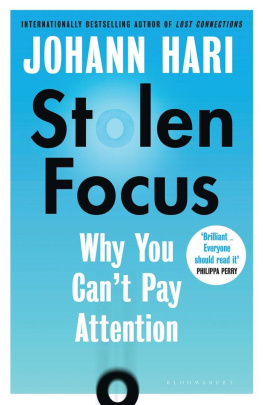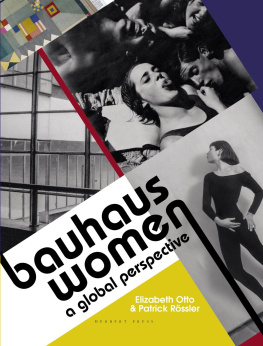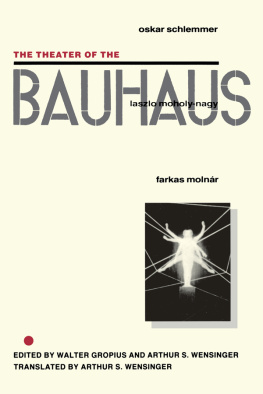Frayling - On Craftsmanship: Towards a New Bauhaus
Here you can read online Frayling - On Craftsmanship: Towards a New Bauhaus full text of the book (entire story) in english for free. Download pdf and epub, get meaning, cover and reviews about this ebook. City: London, year: 2012, publisher: OBERON Books Ltd, genre: Detective and thriller. Description of the work, (preface) as well as reviews are available. Best literature library LitArk.com created for fans of good reading and offers a wide selection of genres:
Romance novel
Science fiction
Adventure
Detective
Science
History
Home and family
Prose
Art
Politics
Computer
Non-fiction
Religion
Business
Children
Humor
Choose a favorite category and find really read worthwhile books. Enjoy immersion in the world of imagination, feel the emotions of the characters or learn something new for yourself, make an fascinating discovery.

- Book:On Craftsmanship: Towards a New Bauhaus
- Author:
- Publisher:OBERON Books Ltd
- Genre:
- Year:2012
- City:London
- Rating:3 / 5
- Favourites:Add to favourites
- Your mark:
- 60
- 1
- 2
- 3
- 4
- 5
On Craftsmanship: Towards a New Bauhaus: summary, description and annotation
We offer to read an annotation, description, summary or preface (depends on what the author of the book "On Craftsmanship: Towards a New Bauhaus" wrote himself). If you haven't found the necessary information about the book — write in the comments, we will try to find it.
Craftsman, and of assorted government reports from all over the Western world, have helped to focus attention on the issue and to give it urgency. It ranges from teaching and training (the value of making things, whatever the subject) right across the spectrum to the stimulation of modern creative industries.
Frayling: author's other books
Who wrote On Craftsmanship: Towards a New Bauhaus? Find out the surname, the name of the author of the book and a list of all author's works by series.
On Craftsmanship: Towards a New Bauhaus — read online for free the complete book (whole text) full work
Below is the text of the book, divided by pages. System saving the place of the last page read, allows you to conveniently read the book "On Craftsmanship: Towards a New Bauhaus" online for free, without having to search again every time where you left off. Put a bookmark, and you can go to the page where you finished reading at any time.
Font size:
Interval:
Bookmark:

First published in 2011 by Oberon Books Ltd.
This electronic edition first published in 2012
Oberon Books Ltd.
521 Caledonian Road, London N7 9RH
Tel: +44 (0) 20 7607 3637 / Fax: +44 (0) 20 7607 3629
e-mail: info@oberonbooks.com
www.oberonbooks.com
Copyright Christopher Frayling, 2011
Christopher Frayling is hereby identified as author of this work in accordance with section 77 of the Copyright, Designs and Patents Act 1988. The author has asserted his moral rights.
You may not copy, store, distribute, transmit, reproduce or otherwise make available this publication (or any part of it) in any form, or binding or by any means (print, electronic, digital, optical, mechanical, photocopying, recording or otherwise), without the prior written permission of the publisher. Any person who does any unauthorized act in relation to this publication may be liable to criminal prosecution and civil claims for damages.
A catalogue record for this book is available from the British Library.
PB ISBN: 978-1-84943-072-2
EPUB ISBN: 978-1-84943-264-1
Visit www.oberonbooks.com to read more about all our books and to buy them. You will also find features, author interviews and news of any author events, and you can sign up for e-newsletters so that youre always first to hear about our new releases.
C RAFTSMANSHIP HAS AGAIN become fashionable in high places, just as it did during the last few recessions. In the boom times of the early 2000s, the public talk was of design: now it is more of craft, a shift which mirrors the parallel move from the creative industries to productive industry and manufacturing. Government ministers extol the joy of technical accomplishment, the beauty of craft skills [in schools] and stress the need for a new, updated Arts and Crafts movement to re-energise good old British inventiveness. There is talk of bringing back long-forgotten technical schools. Policy buffs discuss the parity of esteem between intellectual and practical pursuits, ways of reviving guilds and apprenticeships, whether making properly belongs in higher or further education or both. Too many crafts, one minister has argued, have been given an academic veneer ... [which has] done academic study no favours: better to think of the crafts as vocational. Others prefer to celebrate the achievements of the crafts and design within universities. In the United States, Professor Matthew Crawford a philosopher who also runs a motorcycle repair shop specialising in old European and Japanese models has published an impassioned and best-selling Case For Working With Your Hands or Why Office Work is Bad for Us and Fixing Things Feels Good (originally entitled Shop Class as Soul Craft an enquiry into the value of work (2009)), which argues the morality of getting ones hands dirty by actually making and fixing things, an argument which tries hard to avoid the precious images of manual work that intellectuals sometimes traffic in. The Case relates to the current economic climate in a similar way to Robert Pirsigs Zen and the Art of Motorcycle Maintenance in the mid-1970s with less Plato and more Aristotle and it has made a surprising splash with political analysts on this side of the Atlantic. Are people less likely to throw things away these days? Has the knowledge economy rhetoric been overdone? What about the things you cant get on the internet like hammering a nail or driving a screw the things that have to be performed in person, the things that cant be flown over from China or supplied down the wire.
Meanwhile, Alain de Botton has assembled The Pleasures and Sorrows of Work (2009), a collage of examples around the question when does a job feel meaningful. And New York sociologist Richard Sennett has, in The Craftsman (2008), examined the desire to do a job well for its own sake from historical, sociological and philosophical perspectives as the characteristic that distinguishes us from other life forms. He is convinced the desire resides in all of us.
So craftsmanship is definitely in the ether, as an idea ripe to be reclaimed, re-evaluated and redefined an idea that should shed its tendency to speak its name with a cringe, an upward cadence of the voice. Lets hear it for making things as best we can.
But ... craftsmanship and the crafts are not as simple as they sound.
The commonsense definition of the word craft seems clear enough: an activity which involves skill in making things by hand; derived from the old English craeft meaning strength or skill. But on closer inspection the word becomes more and more difficult to pin down a short word that has been stretched in recent years almost to breaking point. Big manufacturers like to promote their wares with the language of craft hand-made, hand-finished, made by our craftsmen, uniquely for you cousin of the language of organic, to reassure their anxious customers. Recent global campaigns using the imagery of craft have included Levis Craftwork with sixteen London craftworkers as the face of the campaign and Campers Extraordinary Crafts range of shoes, revealing through a piece of performance art that creativity has been applied to every process. The word craft is usually assumed by the ad-people to be associated in the public mind with the values of the recent past rather than the present, with the good old pre-digital days. And some products still, apparently, embody these values. The assumption is that when you are in danger of losing something, it becomes specially precious to you. This, at the same time as manuals of business management and public administration have been hijacking the language of the Modernist avant-garde (usually the Bauhaus) to show how forward-thinking they have become fitness for purpose, making the form follow the function, out of the box, not to mention any number of palettes, sculptings, broad-brushes, frames of reference, patinas, cutting-edges, templates, tools, tool-boxes, stonewallings, carvings of niches, building of brands and cuttings of ones coat according to ones cloth.
It all depends on where you are coming from. To a sociologist, the word craft is associated with skilled manual labour or the aristocracy of labour. To an economist, with a stage in economic development preceding capitalism (there are overlaps and fusions between the two stages). To an anthropologist, with the maker as user, with homo faber or the maker of things and homo ludens or the deep play of everyday life. To a countryman, with traditional rural pursuits. To a literary historian, with the anti-establishment stance of the Romantics. To a trade unionist, with a community of skilled people defending the way they perform their occupations. To a laboratory scientist, with the use of equipment to do science a contemporary version of Galileos dialogue between Galileo the astronomer and Galileo the builder of the telescope, the starry messenger. In Germany during the 1920s-1930s, the culture of craft and of anti-modernism was strongly associated with the political Right; in Britain during the 1880s-1890s through the writings of William Morris, Walter Crane and disciples with the political Left: similar repertoire of arguments, radically opposed conclusions. In Germany, this became a popular movement, centred on disaffected artisanal businesses; in Britain, it was mainly confined to the artistic realm and was much better tempered. All in the name of craft. Policy-makers today prefer to see craft as a stimulus to local or regional economies, skills and materials, sometimes in relation to wider networks. To an art critic, the word craft is about the distinction between an art as in intellectual/conceptual and a mere craft as in manual a debased version of age-old debates about the social recognition of the artist which go back to the Italian Renaissance, sharpened in England by Royal patronage of fine artists. On this one, Turner prize-winner Grayson Perry recently delivered a show-stopper: I think the art world had more trouble coming to terms with me being a potter than with my choice of frocks. If you call your pot art you are being pretentious; but if you call your shark art you are being philosophical! So ironically to an art school-educated craftsperson, the word now has unfortunate associations with manual skill which rather get in the way of making art. To a designer, craft is about the workmanship of risk and most recently the slow design movement. Meanwhile, artist Damien Hirst has confessed that the word skill always reminds him of macram
Font size:
Interval:
Bookmark:
Similar books «On Craftsmanship: Towards a New Bauhaus»
Look at similar books to On Craftsmanship: Towards a New Bauhaus. We have selected literature similar in name and meaning in the hope of providing readers with more options to find new, interesting, not yet read works.
Discussion, reviews of the book On Craftsmanship: Towards a New Bauhaus and just readers' own opinions. Leave your comments, write what you think about the work, its meaning or the main characters. Specify what exactly you liked and what you didn't like, and why you think so.








